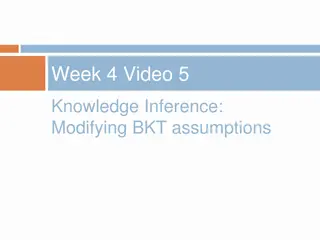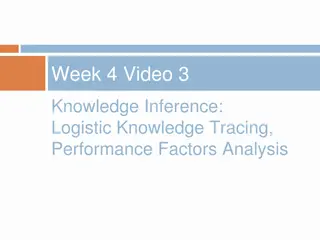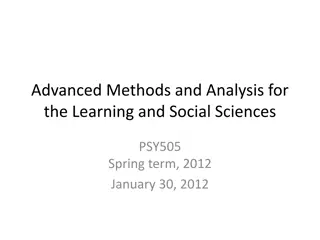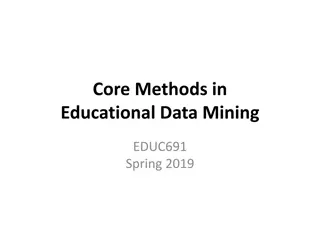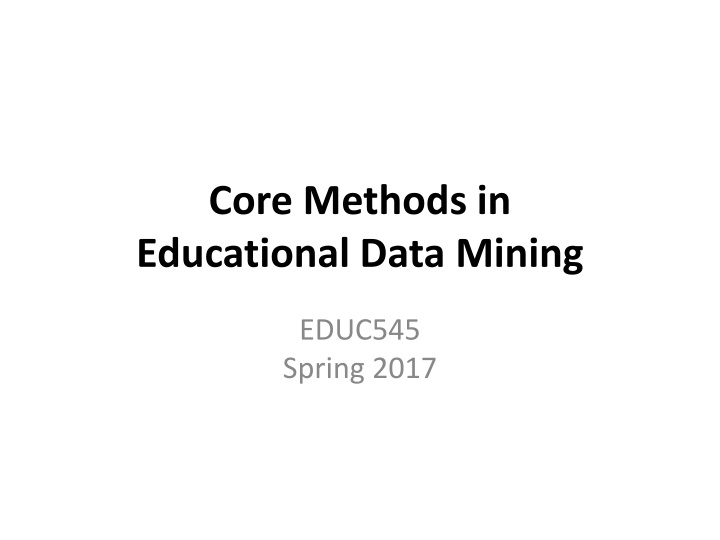
Methods in Educational Data Mining for Knowledge Inference
Explore the core methods in educational data mining for knowledge inference, including the goal of measuring student knowledge, key assumptions of BKT model, and model performance assumptions. Understand the two-state learning model, skill parameters, and more to enhance educational outcomes.
Download Presentation

Please find below an Image/Link to download the presentation.
The content on the website is provided AS IS for your information and personal use only. It may not be sold, licensed, or shared on other websites without obtaining consent from the author. If you encounter any issues during the download, it is possible that the publisher has removed the file from their server.
You are allowed to download the files provided on this website for personal or commercial use, subject to the condition that they are used lawfully. All files are the property of their respective owners.
The content on the website is provided AS IS for your information and personal use only. It may not be sold, licensed, or shared on other websites without obtaining consent from the author.
E N D
Presentation Transcript
Core Methods in Educational Data Mining EDUC545 Spring 2017
What is the Goal of Knowledge Inference?
What is the Goal of Knowledge Inference? Measuring what a student knows at a specific time Measuring what relevant knowledge components a student knows at a specific time
Why is it useful to measure student knowledge?
Key assumptions of BKT Assess a student s knowledge of skill/KC X Based on a sequence of items that are scored between 0 and 1 Classically 0 or 1, but there are variants that relax this Where each item corresponds to a single skill Where the student can learn on each item, due to help, feedback, scaffolding, etc.
Key assumptions of BKT Each skill has four parameters From these parameters, and the pattern of successes and failures the student has had on each relevant skill so far We can compute Latent knowledge P(Ln) The probability P(CORR) that the learner will get the item correct
Key assumptions of BKT Two-state learning model Each skill is either learned or unlearned In problem-solving, the student can learn a skill at each opportunity to apply the skill A student does not forget a skill, once he or she knows it
Model Performance Assumptions If the student knows a skill, there is still some chance the student will slip and make a mistake. If the student does not know a skill, there is still some chance the student will guess correctly.
Classical BKT p(T) Not learned Learned p(L0) p(G) 1-p(S) correct correct Two Learning Parameters p(L0) problem solving. Probability the skill is already known before the first opportunity to use the skill in p(T) Probability the skill will be learned at each opportunity to use the skill. Two Performance Parameters p(G) Probability the student will guess correctly if the skill is not known. p(S) Probability the student will slip (make a mistake) if the skill is known.
Assignment B5 Let s go through the assignment together
Filter out all actions from (a copy of) the data set, until you only have actions for KC VALUING-CAT-FEATURES . How many rows of data remain?
Filter out all actions from (a copy of) the data set, until you only have actions for KC VALUING-CAT-FEATURES . How many rows of data remain? Correct answer: 2473 Other known answer: 2474 ( Almost. You have also included the header row. What is the total when you eliminate that? ) Other known answer: 124370 or 124371 ( You haven t removed anything. ) Other known answer: 121897 or 121898 ( Oops! You deleted VALUING-CAT-FEATURES instead of keeping that. )
We need to delete some rows, based on the assumptions of Bayesian Knowledge Tracing. With reference to the firstattempt column, which rows do we need to delete? Firstattempt = 1 Firstattempt = 0 No rows All rows
We need to delete some rows, based on the assumptions of Bayesian Knowledge Tracing. With reference to the firstattempt column, which rows do we need to delete? Firstattempt = 1 Firstattempt = 0 No rows All rows
Go ahead and delete the rows you indicated in question 2. How many rows of data remain? Correct answer: 1791
Were going to create a Bayesian Knowledge Tracing model for VALUING-CAT-FEATURES. Create variable columns P(Ln-1) (cell I1), P(Ln-1|RESULT) (cell J1), and P(Ln) (cell K1), and leave the columns below them empty for now. (If you re not sure what these represent, re-watch the lecture). To the right of this, type into four cells, (cell M2) L0, (M3) T, (M4) S, and (M5) G. Now type 0.3, 0.1, 0.2, and 0.25 to the right of (respectively) L0, T, S, and G (e.g. cells N2, N3, N4, N5). What is your slip parameter?
Were going to create a Bayesian Knowledge Tracing model for VALUING-CAT-FEATURES. Create variable columns P(Ln-1) (cell I1), P(Ln-1|RESULT) (cell J1), and P(Ln) (cell K1), and leave the columns below them empty for now. (If you re not sure what these represent, re-watch the lecture). To the right of this, type into four cells, (cell M2) L0, (M3) T, (M4) S, and (M5) G. Now type 0.3, 0.1, 0.2, and 0.25 to the right of (respectively) L0, T, S, and G (e.g. cells N2, N3, N4, N5). What is your slip parameter? Correct answer: 0.2
Just temporarily, set K3 to have = I2+0.1, and propagate that formula all the way down (using copy- and-paste, for example), so that K4 has = I3+0.1, and so on (this pretends that the student always gets 10% better each time, even going over 100%, which is clearly wrong we ll fix it later). What should the formula be for Column I, P(Ln-1)? If you re not sure which of these is right, try them each in Excel. Now, what should the formula for cell I2 be?
Propagate the correct formula for column I all the way down (using copy-and-paste). Just temporarily, set J2 to have =I2, and propagate that formula all the way down (this eliminates Bayesian updating, which is not correct within BKT we ll fix it later). Now, what should the formula for cell K2 be, to correctly represent learning based on the P(T) parameter?
If a student starts the tutor and then gets 3 problems right in a row for the skill, what is his/her final P(Ln) after these three problems?
If a student starts the tutor and then gets 3 problems wrong in a row for the skill, what is his/her final P(Ln)?
Assignment B5 Any questions?
Parameter Fitting Picking the parameters that best predict future performance Any questions or comments on this?
Overparameterization BKT is thought to be overparameterized (Beck et al., 2008) Which means there are multiple sets of parameters that can fit any data
Degenerate Space (Pardos et al., 2010)
Parameter Constraints Proposed Beck P(G)+P(S)<1.0 Baker, Corbett, & Aleven (2008): P(G)<0.5, P(S)<0.5 Corbett & Anderson (1995): P(G)<0.3, P(S)<0.1 Your thoughts?
Does it matter what algorithm you use to select parameters? EM better than CGD Chang et al., 2006 CGD better than EM Baker et al., 2008 A = 0.05 A = 0.01 EM better than BF Pavlik et al., 2009 Gong et al., 2010 Pardos et al., 2011 Gowda et al., 2011 BF better than EM Pavlik et al., 2009 Baker et al., 2011 A = 0.003, A = 0.01 A = 0.005 RMSE= 0.005 A = 0.02 A = 0.01, A = 0.005 A = 0.001 BF better than CGD Baker et al., 2010 A = 0.02
Other questions, comments, concerns about BKT?
Next Assignment Basic assignment 6
Final Projects Let s discuss final projects Final project presentations 5/2 9am-11am
Next Class Wednesday, April 5 B6: Performance Factors Assessment and Deep Knowledge Tracing Baker, R.S. (2015) Big Data and Education. Ch. 4, V3. Pavlik, P.I., Cen, H., Koedinger, K.R. (2009) Performance Factors Analysis -- A New Alternative to Knowledge Tracing. Proceedings of AIED2009. Pavlik, P.I., Cen, H., Koedinger, K.R. (2009) Learning Factors Transfer Analysis: Using Learning Curve Analysis to Automatically Generate Domain Models. Proceedings of the 2nd International Conference on Educational Data Mining. Khajah, M., Lindsey, R. V., & Mozer, M. C. (2016) How Deep is Knowledge Tracing? Proceedings of the International Conference on Educational Data Mining.

